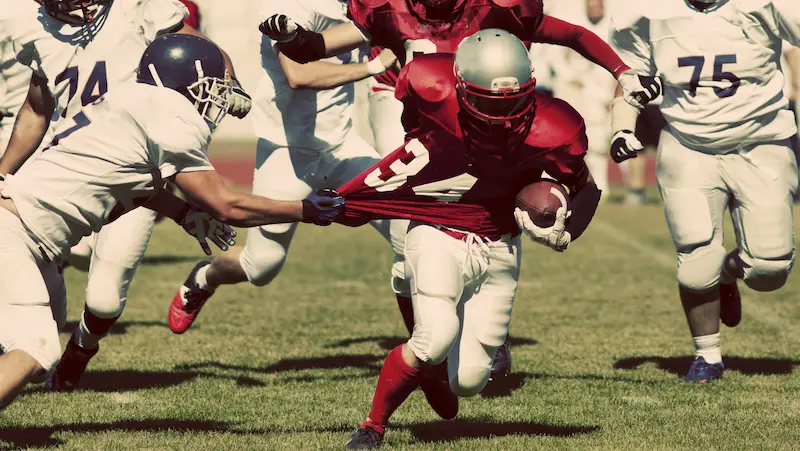College football has always held a special place in the hearts of sports enthusiasts especially across the United States. From the storied rivalries that ignite passion in fans to the young athletes chasing their dreams on the gridiron, the game has captivated our attention for well over a century. As we step into the exciting realm of 2023, it’s only natural to wonder how this beloved sport continues to evolve and adapt to the changing landscape of collegiate athletics.
In this blog, we’ll dive deep into the exciting world of college football, exploring the trends that are set to shape the game in the year 2023 and beyond. From advancements in player safety and rule changes to the shifting dynamics of conferences and the ever-increasing role of technology, we’ll examine the intricate web of factors that contribute to this sport’s evolution.
Join us on this journey as we navigate the past, present, and future of college football, shedding light on the forces driving its transformation. Whether you’re a die-hard fan, a student-athlete dreaming of the big stage, or simply curious about the game’s ongoing development, this blog is just for you! So, grab your favorite team’s jersey, settle into your seat, and get ready to embark on this journey through the ever-evolving world of college football.
Table of contents
Enhanced Fan Engagement

There’s no denying that the heartbeat of the game lies with the passionate fans who fill stadiums, paint their faces with team colors, and shout their support from the top of their lungs. College football fandom is a culture in itself, a source of camaraderie, and a way of life for many. And in 2023, fan engagement is evolving in ways that bring supporters closer to the game than ever before. Let’s look how is this happening:
1. Augmented Reality (AR) Experiences:
One of the most exciting trends in college football is the integration of augmented reality (AR) technology into the fan experience. With the advent of mobile apps and AR devices, fans can now engage with their favorite teams and players in entirely new ways. Imagine sitting in a stadium, pointing your smartphone at the field, and instantly receiving player stats, live replays, and real-time player information overlaying the action before your eyes. This technology not only enhances the in-game experience but also allows fans to connect with their teams on a deeper level, creating a sense of immersion like never before.
2. Virtual Reality (VR) Tailgating:
Tailgating is a cherished tradition in college football, where fans come together to celebrate, grill, and share their passion before the game. In 2023, VR is taking this pre-game ritual to a whole new level. With VR headsets, fans can now virtually tailgate with fellow supporters from around the world, creating a digital tailgate party that transcends geographical boundaries. This innovative approach not only fosters a sense of community among fans but also introduces new opportunities for fan engagement and interaction.
3. Interactive Social Media Platforms:
Social media has long been a vital tool for fan engagement, but in 2023, platforms are taking it up a notch. College football teams and organizations are harnessing the power of interactive social media campaigns, engaging fans through polls, live Q&A sessions with coaches and players, and behind-the-scenes content. These platforms provide fans with unprecedented access to the inner workings of their favorite teams and make them active participants in the conversation surrounding the game. Doesn’t that sound exciting?
4. Personalized Fan Experiences:
Technology is enabling college football organizations to offer more personalized experiences to fans. From customized merchandise suggestions based on fan preferences to tailored game-day itineraries, the fan experience is becoming increasingly individualized. This personal touch not only makes fans feel more valued but also deepens their emotional connection to the team.
5. In-Stadium Innovations:
Even within the confines of the stadium, fan engagement is evolving. Enhanced Wi-Fi connectivity, stadium apps, and interactive displays are becoming commonplace, allowing fans to access instant replays, order concessions from their seats, and participate in in-game contests. These innovations not only improve the fan experience but also keep fans more engaged with the action on the field.
Player Development and Recruitment

While college football fans eagerly await each season’s kickoff, behind the scenes, a different kind of excitement brews – that of player development and recruitment. In the ever-evolving world of college football, identifying, nurturing, and honing the talents of young athletes is crucial to ensuring the game’s continued excellence. So if you’re a football enthusiast eager to know how you can be a part of the team or are just curious, here’s a closer look at how player development and recruitment are shaping the landscape of college football in 2023.
1. Data-Driven Scouting:
In 2023, data-driven approaches have taken center stage in player recruitment. College football programs are using advanced analytics, tracking technologies, and video analysis to identify promising talents from high schools across the nation. These tools not only help coaches pinpoint players with the right physical attributes but also assess their performance in a more comprehensive and objective manner.
2. Early Commitments and National Signing Day:
High school athletes are committing to colleges as early as their sophomore or junior years. This trend has shifted the dynamics of player development, as colleges now have more time to work with committed athletes, helping them prepare for the collegiate level both athletically and academically. National Signing Day, a long-awaited event for college football fans, has become an even bigger spectacle as young talents officially pledge their allegiance to their chosen programs at the beginning of the year itself.
3. Transfer Portal Impact:
The Transfer Portal has become a game-changer in college football. Players now have the ability to explore new opportunities and transfer to other programs without sitting out a year, thanks to recent NCAA rule changes. This has added a layer of complexity to player recruitment, as college coaches must not only attract high school prospects but also consider potential transfers who can fill immediate gaps in their rosters.
4. Comprehensive Player Development Programs:
Colleges are investing heavily in comprehensive player development programs that go beyond the football field. These programs focus on nurturing athletes academically, emotionally, and socially, providing them with the support they need to succeed both in sports and life. Player development coaches are working closely with student-athletes to help them excel in their studies, develop leadership skills, and navigate the unique challenges of being college athletes.
5. Virtual Training and Analysis:
In a world where distance can be a barrier, virtual training and analysis tools are bridging the gap between coaches and players. Video conferencing, virtual playbooks, and remote skill development sessions have become essential components of player development, allowing coaches to work with athletes regardless of their physical location.
As we venture further into the heart of 2023, player development and recruitment continue to be pivotal aspects of college football’s evolution. The competition to identify and nurture the stars of tomorrow is fiercer than ever, and the methods employed are more sophisticated and data-driven. Let’s now look at how Safety and health are two heroes that play a crucial part in the whole thrill of college football.
Safety and Health

Ensuring the safety and health of players has become a central focus in the evolving landscape of the sport in 2023. Let’s delve into the measures and trends that are shaping the game to be safer and more sustainable for the athletes who grace the gridiron.
1. Enhanced Concussion Protocols:
In recent years, there has been a significant shift in how NCAA college football handles concussions. Rigorous concussion protocols now dictate that players who suffer head injuries must undergo thorough evaluations before returning to the field.
2. Data-Driven Player Monitoring:
Player health and performance are no longer assessed solely by visual observation. In 2023, college football is increasingly relying on data-driven player monitoring. Wearable technology, such as GPS trackers and heart rate monitors, collect real-time data on player exertion levels, helping coaches and medical staff make informed decisions regarding player workload and recovery.
3. Focus on Mental Health:
The mental well-being of college football players has garnered much-needed attention. Programs now prioritize mental health support, providing athletes with access to counselors and mental health professionals. The stigma surrounding mental health in sports is gradually diminishing, allowing athletes to seek help and maintain a healthy mind alongside a strong body. There are also mental health tips for parents that can be useful for kids as they are growing up and deciding to become such athletes !
4. Safer Practice Techniques:
To reduce the risk of injuries during practice, coaches are implementing safer techniques and modifying drills. Tackling and blocking drills now emphasize proper form and technique to minimize the chances of high-impact collisions. This proactive approach helps preserve player health over the course of the season.
5. Comprehensive Nutrition and Recovery Programs:
Nutrition and recovery are integral components of athlete health. College football programs are now offering tailored nutrition plans and recovery regimens to optimize player performance and reduce the risk of injuries. Proper nutrition and adequate rest are seen as essential elements in an athlete’s toolkit.
As we look forward to the future of college football, the emphasis on safety and health is a welcome and necessary evolution. The game continues to thrive, not in spite of these measures, but because of them. By prioritizing the physical and mental health of its athletes, college football ensures that the excitement and passion we all love can be sustained for generations to come. You can also find online safety tips for kids that might help you create general awareness regarding safety for kids. In 2023, it’s not just about gaining college football scores; it’s about safeguarding the future of the sport and the athletes who make it special.
Diversity and Inclusion

College football, deeply rooted in tradition and rivalry, is also experiencing a profound transformation when it comes to diversity and inclusion. Let’s explore some interesting and true facts about how diversity and inclusion are reshaping the landscape of ncaa football 2023.
1. Diverse Coaching Staffs:
College football is seeing a more diverse group of coaches taking on key roles within programs. Historically underrepresented groups, including African Americans and women, are breaking barriers. Notably, women like Sarah Thomas have made inroads as officials in college football, shattering glass ceilings and inspiring a new generation of female football enthusiasts.
2. Increasing Diversity on the Field:
The diversity of players on the field is also on the rise. College football rosters feature athletes from various ethnic, racial, and cultural backgrounds, contributing to the game’s inclusive nature. This diversity is a testament to the sport’s ability to unite individuals from different walks of life.
3. Commitment to Gender Equality:
Women are not only making strides in officiating but also in other roles within college football programs. Many universities are actively promoting gender equality by appointing women to positions such as athletic directors, strength and conditioning coaches, and administrative roles. These women are instrumental in shaping the culture and success of their respective programs.
4. Celebrating Heritage:
College football programs are embracing the diverse heritage of their players. Some teams host special events or cultural celebrations to honor the backgrounds of their athletes. This inclusivity not only creates a sense of belonging but also fosters a deeper connection between players, fans, and the broader community.
5. College Football Scholarships for All:
College football scholarships are no longer limited to just a select few. Scholarships are being awarded to athletes from diverse backgrounds, including those from underserved communities. This approach not only promotes talent development but also opens doors to higher education for a wider range of aspiring athletes.
NCAA Regulations

The world of college football operates under a complex web of rules and regulations set forth by the National Collegiate Athletic Association (NCAA). These rules not only govern the conduct of student-athletes but also shape the way programs recruit, compete, and function. In 2023, understanding NCAA regulations is more crucial than ever for anyone involved in college football. Let’s unravel the intricacies of these regulations and explore their impact on the sport.
1. Amateurism Rules:
One of the cornerstones of NCAA regulations is the concept of amateurism. Student-athletes are expected to maintain their amateur status, which means they cannot receive compensation beyond their scholarship and certain allowable expenses. This rule aims to preserve the integrity of college athletics and prevent undue commercialization.
2. Eligibility Requirements:
To compete in NCAA college football, student-athletes must meet specific eligibility requirements, including academic standards and amateur status. Eligibility is a critical factor in determining a player’s ability to participate in games and receive scholarships.
3. Recruiting Regulations:
The NCAA college football has stringent rules governing the recruitment of high school athletes. Coaches and programs must adhere to specific timelines and guidelines for contacting and offering scholarships to prospective student-athletes. Violating these rules can result in sanctions for both coaches and programs.
4. Transfer Portal:
In recent years, the NCAA college football introduced the Transfer Portal, allowing student-athletes more flexibility to transfer between schools without penalty. However, specific regulations and eligibility requirements still apply, and navigating the transfer process can be complex.
5. Name, Image, and Likeness (NIL):
One of the most significant recent developments in NCAA regulations is the introduction of NIL rights for student-athletes. In 2021, the NCAA changed its rules to allow athletes to profit from their name, image, and likeness. This change has opened up new opportunities for athletes to earn income through endorsements, sponsorships, and other commercial ventures.
6. Academic Progress and Graduation Rates:
NCAA college football regulations also emphasize the importance of academic success. Programs are held accountable for the academic progress and graduation rates of their student-athletes. This ensures that the student-athlete experience extends beyond the playing field and includes a commitment to education.
7. Compliance and Enforcement:
To ensure that colleges and universities adhere to NCAA regulations, each institution has a compliance office responsible for monitoring and enforcing the rules. Failure to comply with NCAA regulations can result in sanctions, including loss of scholarships, postseason bans, and financial penalties.
8. Evolving Landscape:
The world of NCAA regulations is not static. It is continually evolving in response to legal challenges, societal changes, and the needs of student-athletes. Recent developments, such as NIL rights and changes to transfer rules, reflect the NCAA’s efforts to adapt to the modern landscape of college athletics.

Conclusion
It’s abundantly clear that the sport we love continues to transform, adapt, and inspire. The trends we’ve explored in this blog are not merely fleeting fads but rather signposts pointing to the future of the game. The NCAA college football landscape is poised for change, offering us a tantalizing glimpse of what’s to come.
From the integration of advanced analytics and player tracking to the ongoing debate surrounding player compensation, these trends signify a broader shift in the sport’s ethos. College football is no longer a static tradition; it’s a dynamic organism, constantly evolving to meet the needs and expectations of its players, fans, and stakeholders.
The journey ahead may be marked by challenges and debates, but it is also filled with boundless potential and opportunities for growth. As enthusiasts, let us embrace the changes and keep a watchful eye on the trends that will undoubtedly shape the college football landscape in the years to come. If you’re a parent who wants to introduce their kids to sports like football, do checkout children’s summer programs that can get them going!
To get your hands on more educational and free resources on coding for kids, robotics for kids, financial education for kids, etc., do check out the BrightCHAMPS Page now!
To explore more trending and informative topics, be sure to visit BrightChamps’ blog page today!
Frequently Asked Questions (FAQs)
A1. The transfer portal is a database where college athletes can enter their names to express their intent to transfer to another school. It has increased player mobility and changed team dynamics.
A2. Augmented reality stadiums provide fans with real-time data, replays, and player statistics on their smartphones, making the game more immersive.
A3. NIL policies allow college athletes to profit from their name, image, and likeness, creating opportunities for endorsements and sponsorships.
A4. Diversity in coaching staff brings different perspectives and strategies, ultimately benefiting the team’s performance and player development.
A5. Colleges are adopting eco-friendly practices in stadiums and exploring sustainable travel options to reduce the sport’s environmental impact while maintaining its competitiveness.


 We are an army of educators and passionate learners from BrightChamps family, committed to providing free learning resources to kids, parents & students.
We are an army of educators and passionate learners from BrightChamps family, committed to providing free learning resources to kids, parents & students.














